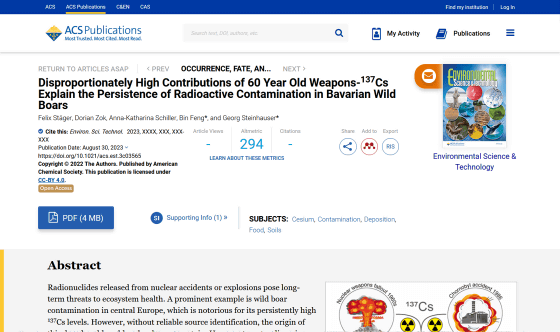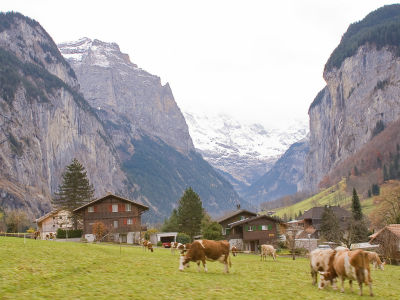The reason why wild boars living in Germany are contaminated with high concentrations of radioactive materials is revealed

Disproportionately High Contributions of 60 Year Old Weapons-137Cs Explain the Persistence of Radioactive Contamination in Bavarian Wild Boars | Environmental Science & Technology
https://doi.org/10.1021/acs.est.3c03565

The wild boar paradox - finally solved | EurekAlert!
https://www.eurekalert.org/news-releases/1000093
Wild Pigs in Germany Are Mysteriously Radioactive, And We Finally Know Why : ScienceAlert
https://www.sciencealert.com/wild-pigs-in-germany-are-mysteriously-radioactive-and-we-finally-know-why
The Chernobyl nuclear power plant accident had a major impact on forest ecosystems in Central Europe, and even in Germany, which does not border on present-day Ukraine, it is known that a large amount of radioactive material has accumulated in the bodies of wild boars. . In Saxony, Germany, wild boars caught in the wild are required to undergo radiological examinations to determine whether they are suitable for meat consumption. Radioactivity has been detected.
The current situation of wild boars in Germany, which carry the negative legacy of Chernobyl - GIGAZINE

However, there is one question about the high levels of radioactivity still detected in German boars. The half-life of the radioactive material cesium 137 , which was released in large amounts by the Chernobyl nuclear power plant accident, is about 30 years, and the amount that exists in nature should have been halved 30 years after the accident. Also, radioactive materials can be washed away by rainwater or can combine with minerals and penetrate deep into the soil, so after one half-life most food samples, including deer, have low levels of radioactive contamination. Masu.
Despite this, for some reason only wild boar meat remains radioactively contaminated at the same concentration as before, and this phenomenon is also called the ``boar paradox''. Boar meat with radiation levels exceeding the permissible limit is not suitable for consumption, so in some areas of Germany, the boar population is difficult to reduce through hunting, and damage to agricultural crops is also a problem.
Therefore, a research team from the University of Hannover in Germany and the Vienna University of Technology in Austria attempted to solve this boar paradox by identifying the source of radioactive substances contained in the boar's body. The isotope ratio of radioactive materials released in nuclear power plant accidents, nuclear tests, etc. differs, so if you measure the ratio of cesium-137 and cesium-135, which has a longer half-life, you can determine which event the cesium came from. It is said that it is possible to specify what it is.

The research team collected samples from wild boars captured from 2019 to 2021 in Bavaria, Germany, and measured cesium isotope ratios using a high-purity gamma-ray detector and
The following is a pie chart showing the sources of cesium that contaminated boar meat, with the blue color representing the Chernobyl nuclear power plant accident that occurred in 1986, and the white color representing cesium derived from nuclear weapons tests in the 1960s. Overall, although more cesium came from the Chernobyl nuclear power plant accident, it was found that 12-68% of the cesium came from nuclear weapons tests. Approximately a quarter of the samples contained cesium from nuclear weapons tests alone, exceeding the legal minimum limit for radioactive contamination, even without contamination from the Chernobyl nuclear power plant accident.

It is thought that the reason why wild boars in Germany are contaminated with cesium not only from the Chernobyl nuclear power plant accident but also from older nuclear weapons tests is thought to be due to the truffles that boars love to eat.
Truffles are a type of mushroom that grows underground, and the radioactive materials that slowly seep into the soil contaminate the truffles over time. Because boars dig up these truffles from the ground and eat them, they eat cesium from nuclear weapons tests conducted in the 1960s in the 1980s and 1990s, and in recent years they have eaten cesium from the Chernobyl nuclear power plant accident. There is a possibility that they are eating it.
Professor Georg Steinhauser of the Vienna University of Technology says, ``The speed at which cesium moves down the soil is extremely slow, sometimes moving only about 1 mm per year.Truffles that exist at a depth of 20 to 40 cm can be found by now. It is releasing the cesium released by the Chernobyl nuclear power plant accident, while the cesium released by the old nuclear weapon test reached the truffle some time ago.'
In other words, what radioactively contaminated wild boar meat immediately after the Chernobyl nuclear power plant accident was actually not the Chernobyl nuclear power plant accident, but the cesium released by an earlier nuclear weapons test, which has contaminated wild boars in recent years. This is mainly cesium from the Chernobyl nuclear power plant accident. This helps explain the 'boar paradox'.

'Our research shows how complex the interactions in natural ecosystems are,' Steinhauser said. It also shows what can be done.”
Related Posts:






